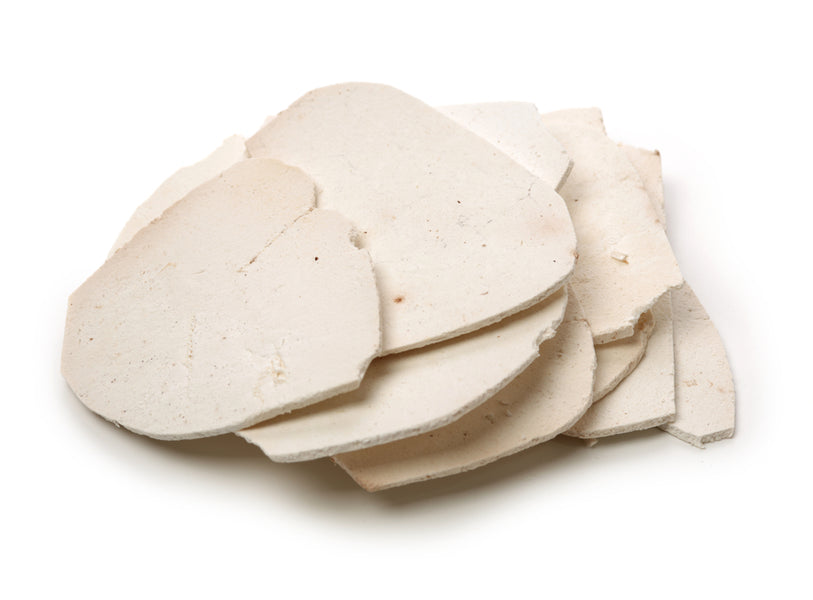Food for Racing Thoughts — This Mushroom Can Reduce Stress & More
Just when we thought fungi couldn’t get more fascinating, we learned about poria. Not only does poria activate brain chemicals to calm down your stress response and improve mood, it also can decrease stress eating and promote heart and gut health.
It won’t make you see rainbows, but poria is still a pretty magic mushroom.
Why We Love Poria
- Most herbal medicines have at least some side effects. It’s to be expected from most ingredients with powerful properties. But not poria. This fabulous fungus has no known side effects.
- Ready for a fungus anatomy lesson? You may see poria referred to as poria sclerotium. This sounds like a latin species name, but sclerotium actually refers to a part of the fungus. It’s a tightly-packed cluster of mycelium, which are little fungus threads. You know that white spiderwebby stuff you sometimes see when digging in the garden? That’s also mycelium, just unraveled. The more you know, right?
Key Benefits:
Women’s Stress Relief - Traditional Chinese Medicine uses mood supplements with poria to reduce occasional symptoms of depression and anxiety, and clinical research agrees. Poria is shown to increase dopamine and serotonin, important brain chemicals that contribute to feelings of well-being and calm. There’s also evidence that poria can decrease inflammation around the brain, which may be a factor in depression.
It’s important to note that women over 40 are the #1 target market for prescription antidepressants and SSRIs. After all, women’s stress relief is a big deal! Still, many women find that herbal women’s stress supplements and a nutritional approach to stress is a great first line of defense. Herbs can even help fill in gaps from a prescription.
May Reduce Stress Eating - It turns out that stress eating isn’t a uniquely human behavior — other animals instinctively respond to stress by seeking sugary foods, too! Researchers tested poria’s ability to reduce stress and stop stress eating on rats, and found that the rats they gave poria stopped binging sugar, even with stressful stimuli. This is good evidence that poria may reduce stress eating, and is part of why we included it in our Stave the Crave herbal chai.
Heart Health - Traditional Chinese Medicine was first to pick up on poria for heart health and blood sugar control, but current science supports this traditional knowledge. Poria may help with insulin resistance, which helps your body process sugar so that it doesn’t all wind up in your blood. This helps with blood sugar levels and even hormone balance. It also has anti-inflammatory properties and is full of antioxidants, which help prevent arterial hardening and heart disease.
Gut Health - The world is waking up to the importance of gut health, and poria is here to help. Research shows that poria can help strengthen the intestinal barrier to reduce leaky gut, bowel disease and even help reduce gluten sensitivity. Bread lovers, rejoice!
Traditional Uses:
Poria has been part of Traditional Chinese Medicine under the name Fu Ling for at least 2000 years. It has been used for:
- Depression & anxiety
- Managing diabetes
- As a diuretic
- A sedative
- Preventing memory loss
- Fighting insomnia
- Tumor reduction
About the Fungus:
Poria’s full latin name is poria cocos because it resembles a coconut growing underground, with a crusty brown exterior and a whitish interior.
Poria is also sometimes called China root (though it’s not technically a root at all), Fu ling and tuckahoe.
It is mainly cultivated in China and Japan, but it can also grow under pine trees across North America and the world.
Found In (Wile Products)
- Stave the Crave herbal drink mix
Things to Know About Poria:
Poria has no known side effects or precautions. Still, it’s always a good idea to chat with your physician before starting an herbal treatment, just in case.
Clinical Research
- Huang, Huai-Syuan, Hsin-Yu Wu, Wan-Ting Chang, Yu-En Lin, Yun-Ju Huang, Kuan-Hung Lu, Yun-Sheng Lu, Mei-Hsing Chen, and Lee-Yan Sheen. “The Antidepressive and Anxiolytic Effects of Formula Consisted of Poria Cocos and Cordyceps Militaris Waster Medium Extract in Unpredictable Chronic Mild Stress Animal Model.” Current Developments in Nutrition 4 (June 1, 2020): nzaa057_028. https://doi.org/10.1093/cdn/nzaa057_028.
- Huang, Yun-Ju, Nai-Yuan Hsu, Kuan-Hung Lu, Yu-En Lin, Shih-Hang Lin, Yun-Sheng Lu, Weiting Liu, Mei-Hsing Chen, and Lee-Yan Sheen. “Poria Cocos Water Extract Ameliorates the Behavioral Deficits Induced by Unpredictable Chronic Mild Stress in Rats by Down-Regulating Inflammation.” Journal of Ethnopharmacology 258 (August 10, 2020): 112566. https://doi.org/10.1016/j.jep.2020.112566.
- Hwang, Youn-Hwan, Seon-A Jang, Ami Lee, Taesoo Kim, and Hyunil Ha. “Poria Cocos Ameliorates Bone Loss in Ovariectomized Mice and Inhibits Osteoclastogenesis In Vitro.” Nutrients 12, no. 5 (May 12, 2020): 1383. https://doi.org/10.3390/nu12051383.
- Dai, Bing, Qinxuan Wu, Chengxi Zeng, Jiani Zhang, Luting Cao, Zi-Zeng Xiao, and Meng-Lin Yang. “The Effect of Liuwei Dihuang Decoction on PI3K/Akt Signaling Pathway in Liver of Type 2 Diabetes Mellitus (T2DM) Rats with Insulin Resistance.” Journal of Ethnopharmacology 192 (November 4, 2016): 382–89. https://doi.org/10.1016/j.jep.2016.07.024.
- Li, Tzu-Hsuan, Chia Hung Hou, Cicero Lee-Tian Chang, and Wen-Chin Yang. “Anti-Hyperglycemic Properties of Crude Extract and Triterpenes fromPoria Cocos.” Evidence-Based Complementary and Alternative Medicine 2011 (January 1, 2011): 1–8. https://doi.org/10.1155/2011/128402.
- Li, Wen-Jun, Jinjin Yu, Jinmeng Zhao, Xin Xiao, Lulu Zang, Jiabao Yu, Haijing Liu, and Xiaofeng Niu. “Poria Cocos Polysaccharides Reduces High‐fat Diet‐induced Arteriosclerosis in ApoE −/− Mice by Inhibiting Inflammation.” Phytotherapy Research 35, no. 4 (April 1, 2021): 2220–29. https://doi.org/10.1002/ptr.6980.
- Li, Xiulian, Yanli He, Pengjiao Zeng, Yong Liu, Rui Zhang, Cui Hao, Hua Wang, Zhihua Lv, and Lijuan Zhang. “Molecular Basis for Poria Cocos Mushroom Polysaccharide Used as an Antitumour Drug in China.” Journal of Cellular and Molecular Medicine 23, no. 1 (January 1, 2019): 4–20. https://doi.org/10.1111/jcmm.13564.
- Sun, Yufei, Zhongfan Liu, Zifeng Pi, Fengrui Song, Jian-Lin Wu, and Shu Liu. “Poria Cocos Could Ameliorate Cognitive Dysfunction in APP / PS1 Mice by Restoring Imbalance of Aβ Production and Clearance and Gut Microbiota Dysbiosis.” Phytotherapy Research 35, no. 5 (January 11, 2021): 2678–90. https://doi.org/10.1002/ptr.7014.
- Xu, Hui, Yuchen Wang, Peter W. Jurutka, Shen Wu, Yadong Chen, Chongjiang Cao, Guitang Chen, Atze Jan Van Der Goot, Sui-Lou Wang, and Shujie Cheng. “16α-Hydroxytrametenolic Acid from Poria Cocos Improves Intestinal Barrier Function Through the Glucocorticoid Receptor-Mediated PI3K/Akt/NF-ΚB Pathway.” Journal of Agricultural and Food Chemistry 67, no. 39 (September 23, 2019): 10871–79. https://doi.org/10.1021/acs.jafc.9b04613.
- Zhao, Jinmeng, Xinyi Niu, Jinjin Yu, Xin Xiao, Wenqi Li, Lulu Zang, Zhen Hu, and Paul Siu-Po Ip. “Poria Cocos Polysaccharides Attenuated Ox-LDL-Induced Inflammation and Oxidative Stress via ERK Activated Nrf2/HO-1 Signaling Pathway and Inhibited Foam Cell Formation in VSMCs.” International Immunopharmacology 80 (March 1, 2020): 106173. https://doi.org/10.1016/j.intimp.2019.106173.
- Zhu, Lixia, Jun Xu, Rujing Wang, Hongxiang Li, Yu-Zhu Tan, Hubiao Chen, Xiao-Ping Dong, and Zhongzhen Zhao. “Correlation between Quality and Geographical Origins of Poria Cocos Revealed by Qualitative Fingerprint Profiling and Quantitative Determination of Triterpenoid Acids.” Molecules 23, no. 9 (August 31, 2018): 2200. https://doi.org/10.3390/molecules23092200.
Sources
- Kelly, John M., Paul J. Kennedy, John F. Cryan, Timothy G. Dinan, Gerard Clarke, and Niall P. Hyland. “Breaking down the Barriers: The Gut Microbiome, Intestinal Permeability and Stress-Related Psychiatric Disorders.” Frontiers in Cellular Neuroscience 9 (October 14, 2015). https://doi.org/10.3389/fncel.2015.00392.Wong, Cathy. “The Health Benefits of Poria Mushrooms.” Verywell Health, May 20, 2022. https://www.verywellhealth.com/the-benefits-of-poria-88643.
- Mushroom Revival. “Poria Cocos Benefits for Health and Wellness*,” n.d. https://www.mushroomrevival.com/pages/poria-cocos.
- RxList. “Poria Mushroom: Health Benefits, Side Effects, Uses, Dose & Precautions,” June 11, 2021. https://www.rxlist.com/poria_mushroom/supplements.htm.
- Vancamelbeke, Maaike, and Severine Vermeire. “The Intestinal Barrier: A Fundamental Role in Health and Disease.” Expert Review of Gastroenterology & Hepatology 11, no. 9 (June 26, 2017): 821–34. https://doi.org/10.1080/17474124.2017.1343143.
This article is intended for informational purposes and is not intended to replace a one-on-one medical consultation with a professional. Wile, Inc researches and shares information and advice from our own research and advisors. We encourage every woman to research, ask questions and speak to a trusted health care professional to make her own best decisions.




